When learning Italian, it’s essential to know the most common Italian words, phrases and expressions that are widely used by natives in everyday conversations. These are the basis for engaging in a polite and effective conversation. When it comes to variety in ways of expressing yourself, Italian is rich in colourful phrases that will elevate your speech and make you sound more like a native!
As proof of this, not only are there several ways to express gratitude, but also there are countless ways to respond! It’s just as important to know how to express your willingness and pleasure to help someone, as it is to say “grazie” (thank you). That is why you should definitely master the most common words and expressions to say things like “No problem!”, and “You’re very welcome” in Italian, plus how to use them in different contexts.
Before we get started, make sure you download your FREE cheat-sheet for this lesson which includes10 ways to say ‘you’re welcome’ in Italian like a native speaker. Just enter your email below and I’ll sent it to you straight away.
Pronti? (Ready?)… Cominciamo! (Let’s get started!)
1. Prego
Pronunciation: preh-goh
Usage: formal/ informal
Example: Grazie per il tuo aiuto! – Prego! (Thank you for your help! – You’re welcome!)
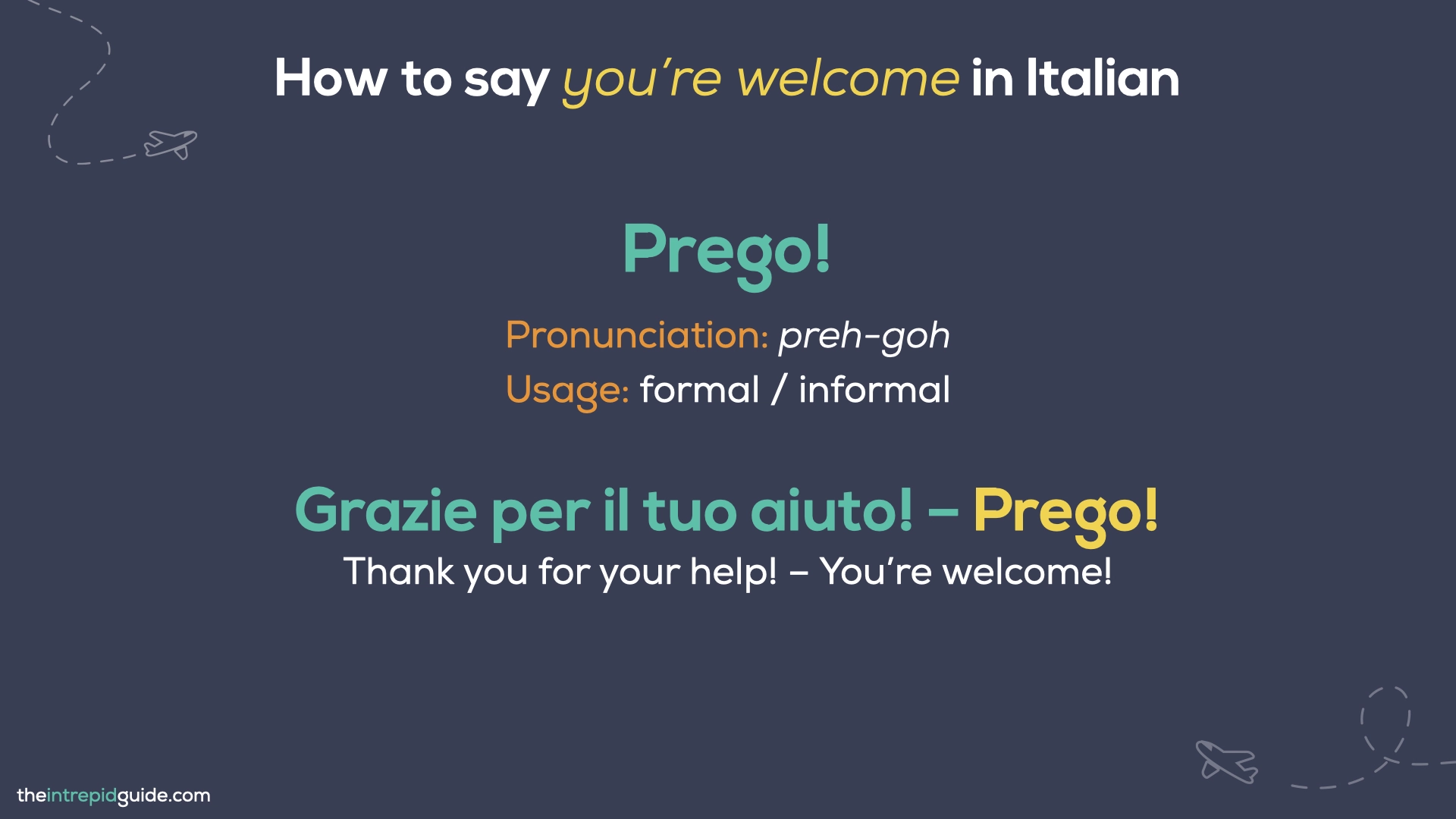 “Prego” is certainly the most popular and frequently used expression and directly translates to the English “you’re welcome”. It’s a standard answer used in response to “grazie”. “Prego” in Italian can be used both in formal and informal situations. This means that you might hear native speakers use it in a variety of interactions: with friends, family members, elderly people, doctors… Basically, any type of exchange regardless of the degree of formality required by the situation.
“Prego” is certainly the most popular and frequently used expression and directly translates to the English “you’re welcome”. It’s a standard answer used in response to “grazie”. “Prego” in Italian can be used both in formal and informal situations. This means that you might hear native speakers use it in a variety of interactions: with friends, family members, elderly people, doctors… Basically, any type of exchange regardless of the degree of formality required by the situation.
However, you’ll be surprised to see that this versatile little word has many other meanings! Eccoli qua (here they are):
5 ways you can use “Prego”
1. Prego also translates to “please” and is a polite word that you can use:
- When you hold the door for someone. For instance: Prego, dopo di Lei. (Please, after you.)
- When you invite someone to sit down. For instance: Prego, si sieda. (Please, have a seat.)
Notice how here “prego” is used in formal contexts and therefore you must use the “Lei” form (that is, the formal “you”) to address someone.
With the same meaning but in a different (much more informal) context you might hear the expression “Ti prego”, which translates to “Please”, “I implore you”, “I’m begging you”. For example:
- Papà, posso usare la tua macchina? Ti prego! (Dad, can I use your car? Pleeeease!)
2. Another situation where you might hear “prego” is from a waiter/waitress or a salesperson when walking in a bar or restaurant or shop. If they greet you with “Buongiorno, prego?” they’re asking “How may I help you?” or (in the case of the bar/ restaurant) “Are you ready to order?”. So don’t look so shocked, they’re not telling you “you’re welcome”, they’re actually starting a conversation with you ;-)
3. The next meaning of “prego” we’re going to look at is when it means “Go ahead!”, which is used as an invitation to speak or give permission to do something after being asked a request. For example,:
- Posso chiederle una cosa? – Certo, prego. (May I ask you something? – Sure, go ahead).
In this context, the usage of “prego” is quite formal.
4. “Prego” is also the first person singular of the verb “pregare”, to pray. “Io prego” or just “prego” therefore both mean, “I pray”.
5. And finally, this little but powerful word can be used as a sort of question that you ask when you want the other person to repeat what they’ve just said. As in “Pardon?”, “Sorry?”, “What was that?”, “Sorry, I didn’t get that”. If your Italian friend is telling you in very fast Italian what their day was like, at some point you might need to stop them and ask to repeat: Prego?
Saying “Prego!” is the main expression you learn to say “you’re welcome”, but there are so many other, more colourful variations you can use! Keep reading to learn all about them ;-)
But first, here is a little task for you! Read the following sentences and try to understand which meaning “prego” has in each of them, and translate it into English.
You’ll find the answers at the end of the guide!
- Prego Signori, da questa parte.
- Grazie, sei davvero gentile. – Prego!
- Buongiorno, prego! – Salve, vorrei un cappuccino e un cornetto, per favore.
- Sono una persona molto religiosa, prego tutti i giorni.
- Ieri ho cucinato i paccheri al salmone. – Prego?
- Posso usare il telefono? – Prego!
2. Di niente! / Di nulla!
Pronunciation: dee nyehn-teh / dee nool-lah!
Usage: formal/ informal
Example: Grazie per la cena! – Di nulla! (Thank you for dinner! – It was nothing!)
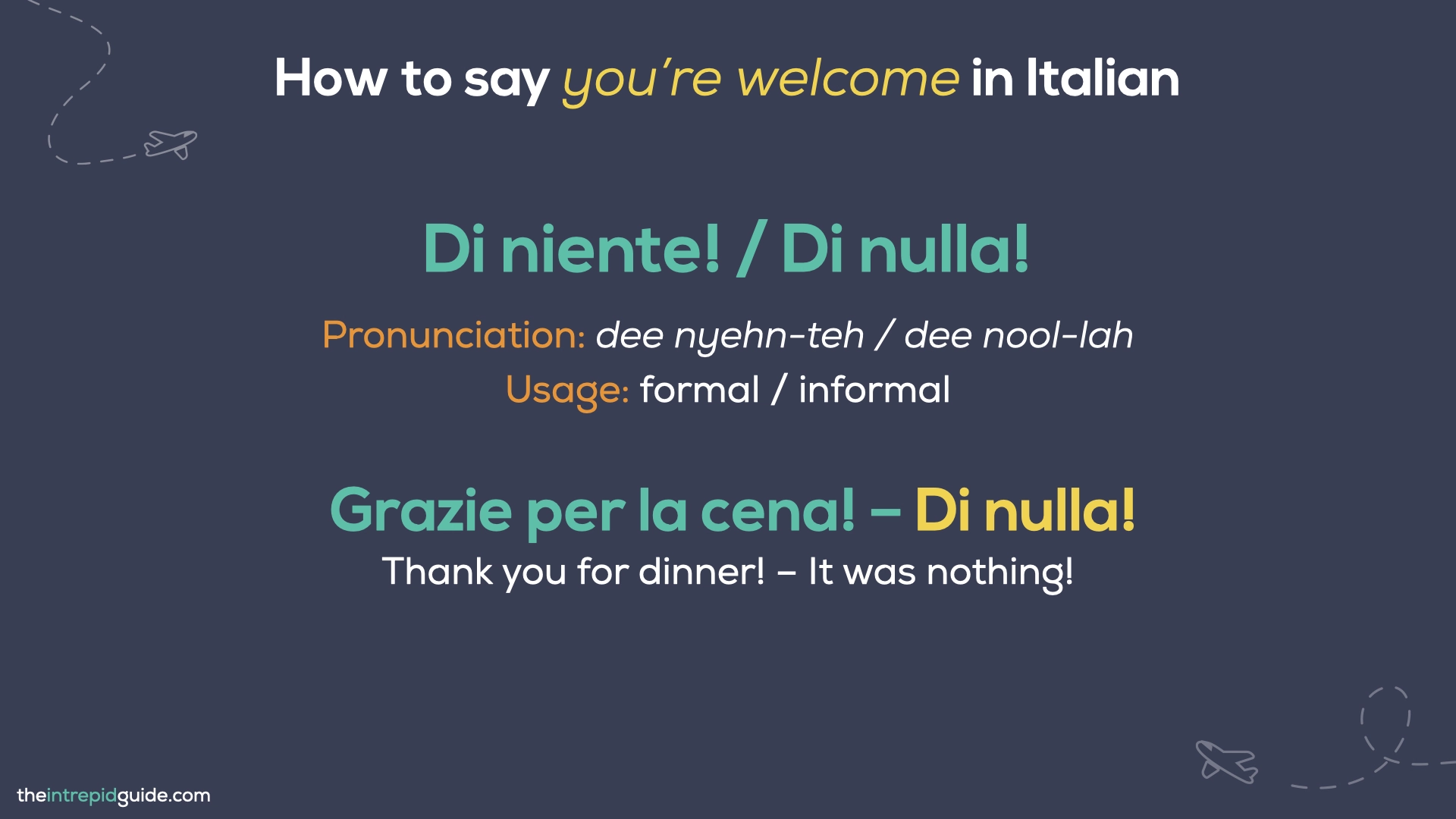 These phrases literally mean “of nothing” (“niente” and “nulla” are synonyms that translate to “nothing”) and they are interchangeable. They’re frequently used and quite neutral, that is, like “prego”, you can use them in both formal and informal contexts. You can use them to express your willingness to help or do something by saying that there was no inconvenience caused.
These phrases literally mean “of nothing” (“niente” and “nulla” are synonyms that translate to “nothing”) and they are interchangeable. They’re frequently used and quite neutral, that is, like “prego”, you can use them in both formal and informal contexts. You can use them to express your willingness to help or do something by saying that there was no inconvenience caused.
3. Ci mancherebbe (altro)
Pronunciation: chee man-keh-reb-beh (al-troh)
Usage: formal/ informal
Example: Grazie, sei un tesoro! – Ci mancherebbe altro! (Thank you, you’re a sweetheart! – Don’t even mention it!)
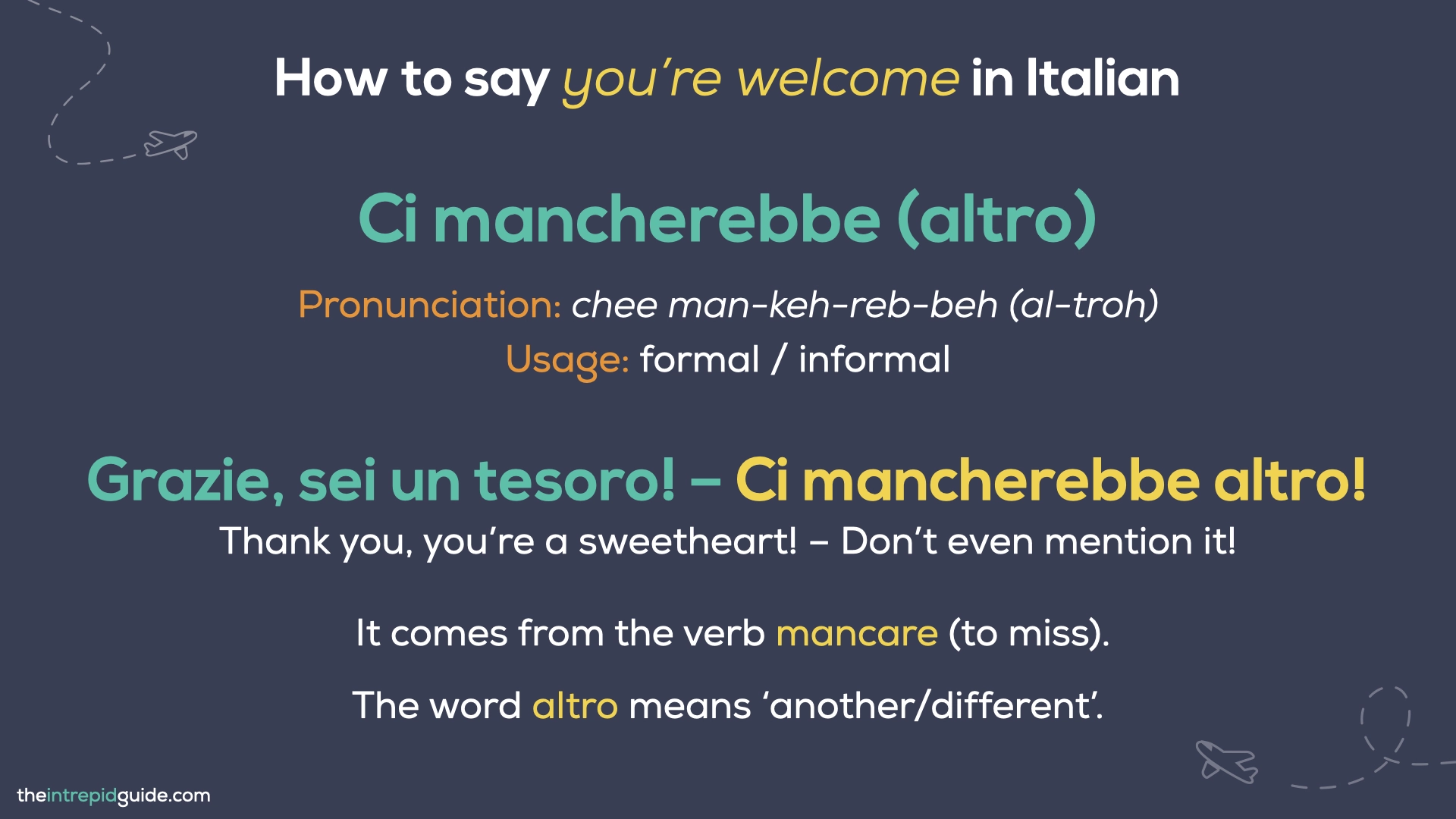 This highly idiomatic expression would translate literally as “there would miss (something else)”, which sounds a bit odd in English but it is a popular (albeit less common than “prego” and “di nulla/niente”) way Italians use to say “you’re welcome”. It comes from the verb “mancare” (to miss) but its actual meaning has nothing to do with that. You could translate it as “Don’t even mention it”, “You’re very welcome” or “It was a pleasure”.
This highly idiomatic expression would translate literally as “there would miss (something else)”, which sounds a bit odd in English but it is a popular (albeit less common than “prego” and “di nulla/niente”) way Italians use to say “you’re welcome”. It comes from the verb “mancare” (to miss) but its actual meaning has nothing to do with that. You could translate it as “Don’t even mention it”, “You’re very welcome” or “It was a pleasure”.
“Ci mancherebbe (altro)” is very emphatic and fits in both formal and informal contexts. The word “altro” (another/different) doesn’t add anything special to the phrase, so both versions are accepted.
4. Ma ti pare?
Pronunciation: mah tee pah-reh?
Usage: informal
Example: Grazie mille, ti devo un favore! – Ma ti pare? (Thank you so much, I owe you one! – Don’t mention it/ No worries!)
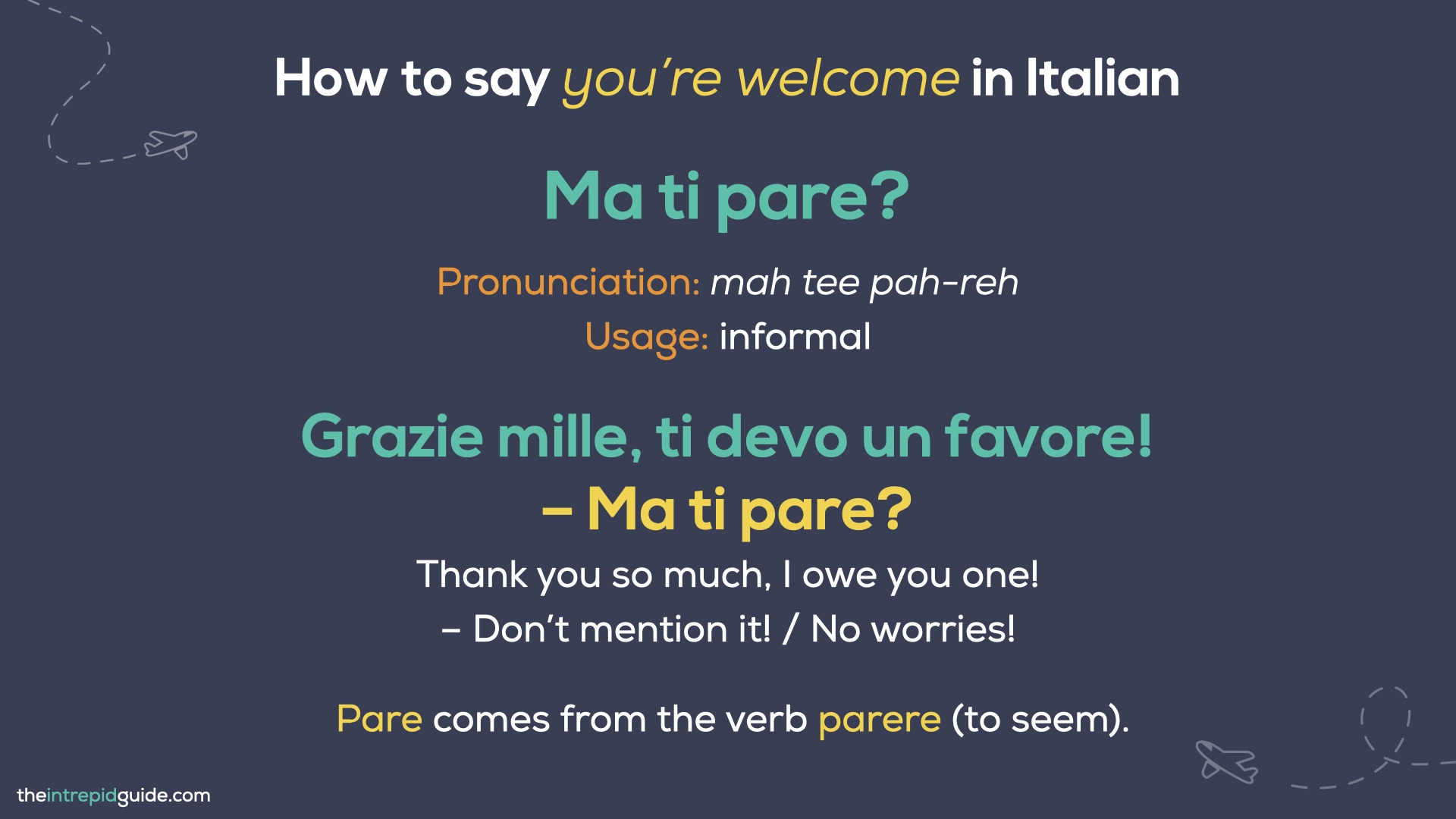 The next phrase to say “you’re welcome” in Italian is also very idiomatic, meaning, it can’t be translated literally. It is actually quite hard to find a proper translation in English for this one. How come? Because sometimes Italians use typical expressions whose meaning is clear only to native speakers because they’re part of the common usage – but to foreigners, they don’t make any sense! “Ma ti pare?” is one of them! In English, it would translate to something like “but does it seem to you?”, because it derives from the verb “parere” (to seem).
The next phrase to say “you’re welcome” in Italian is also very idiomatic, meaning, it can’t be translated literally. It is actually quite hard to find a proper translation in English for this one. How come? Because sometimes Italians use typical expressions whose meaning is clear only to native speakers because they’re part of the common usage – but to foreigners, they don’t make any sense! “Ma ti pare?” is one of them! In English, it would translate to something like “but does it seem to you?”, because it derives from the verb “parere” (to seem).
Unlike the previous examples, this expression is mainly used in informal contexts, that is, with friends, peers, and close acquaintances. It fits those situations where a person expresses extreme gratitude and another one responds to it with a high level of enthusiasm for being able to be of assistance or help.
5. Figurati! / Si figuri!
Pronunciation: fee-goo-rah-tee! / see fee-goo-ree!
Usage: informal/ formal
Example: Grazie del regalo. – Figurati! (Thanks for the present. – My pleasure/ Anytime/ Don’t mention it!)
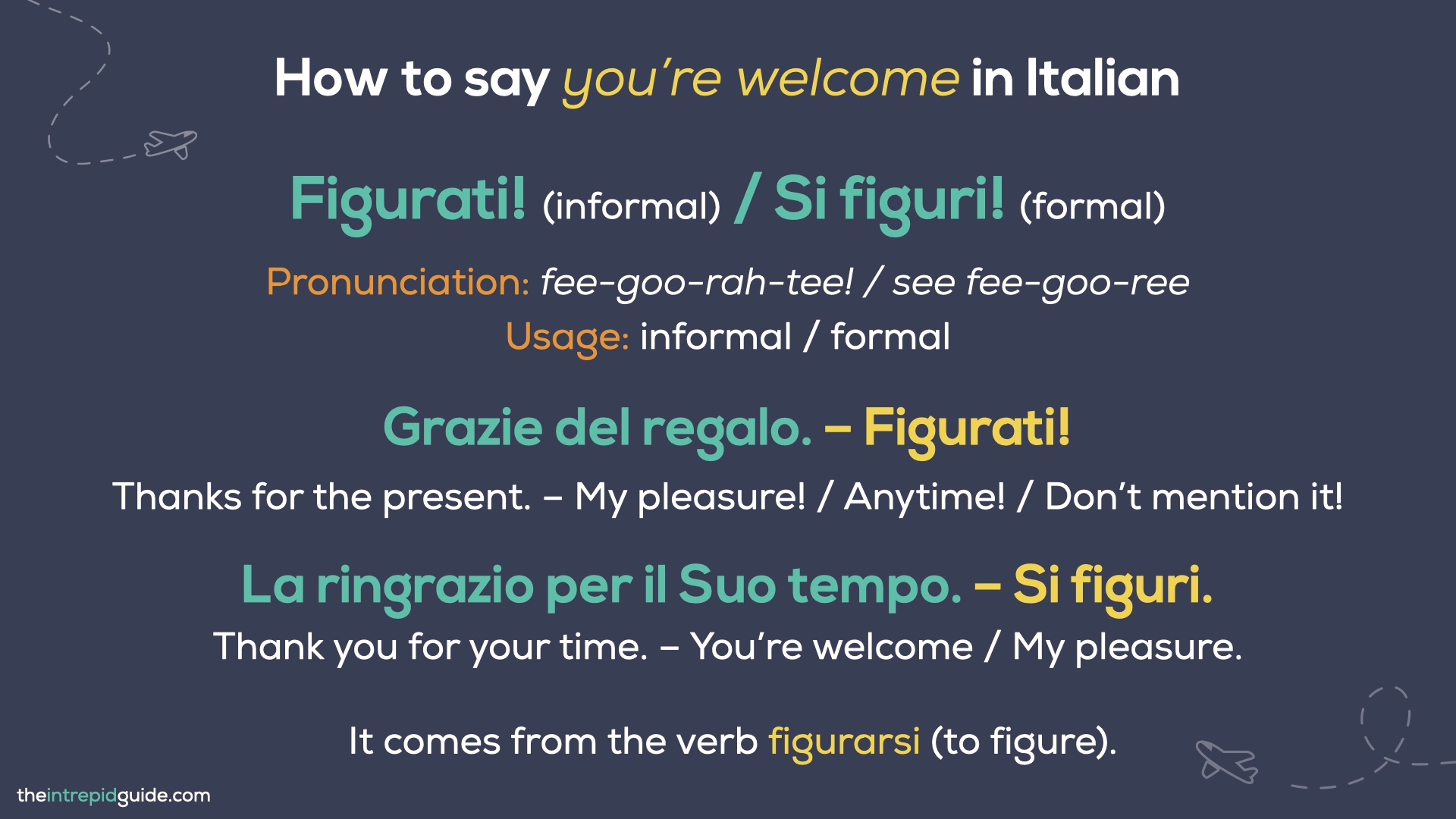 The next two expressions used in Italian to say “you’re welcome” come from the verb “figurarsi” (to imagine, to figure), but once again they are used figurativamente (figuratively). No pun intended ;-)
The next two expressions used in Italian to say “you’re welcome” come from the verb “figurarsi” (to imagine, to figure), but once again they are used figurativamente (figuratively). No pun intended ;-)
The informal version, “figurati”, is a much friendlier way to say “prego” and conveys the idea of “my pleasure”, “happy to help”, “anytime”. For instance, if you give your Italian friend a present, you can reply to their “grazie!” with a “figurati!”.
On the other hand, the formal version, “si figuri”, is also friendly but at the same time very polite. For example:
- La ringrazio per il Suo tempo. – Si figuri. (Thank you for your time. – You’re welcome/ My pleasure.)
Like “prego”, “figurati” can have different meanings too, depending on the situation where it’s used. Take a look at the following sentences:
- Pensi che lo chiamerò? Figurati! (You think I’m going to call him? No way!)
- Non viaggia mai nel suo Paese, figurati all’estero. (She never travels in her own country, let alone abroad.)
6. Ma scherzi!
Pronunciation: mah skehr-tsee!
Usage: informal
Example: Grazie per avermi aiutato! – Ma scherzi! (Thanks for helping me! – Don’t mention it/ Of course!)
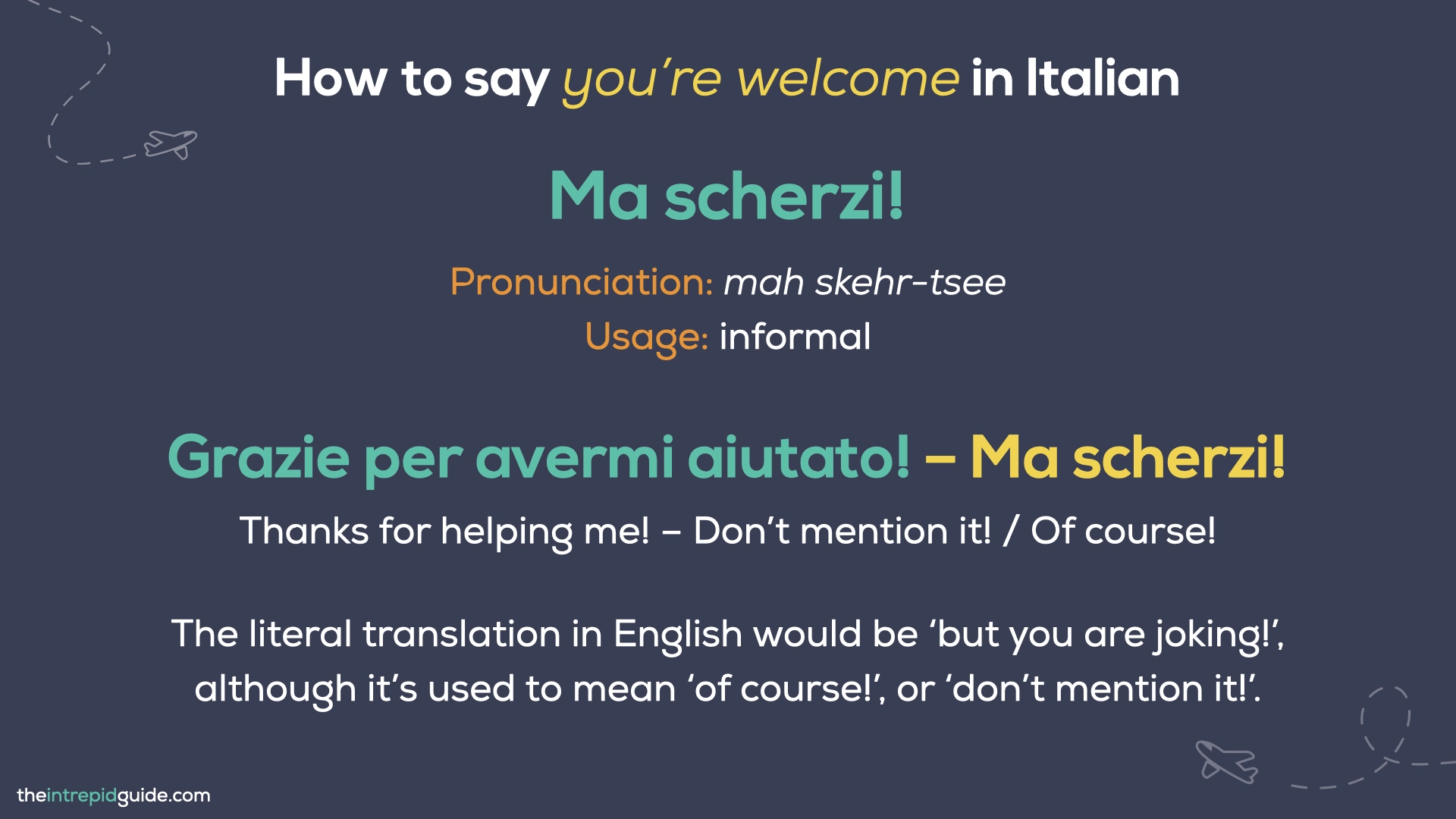 The phrase “Ma scherzi!” (uttered in a tone between a question and an exclamation) is very similar to “Ma ti pare?”, which means it’s used mostly in informal contexts. It’s a very enthusiastic and emphatic way to express your pleasure to help or do something for someone, such as a friend. The literal translation in English would be “but you are joking!”, although it’s used to mean “of course!”, or “don’t mention it!”.
The phrase “Ma scherzi!” (uttered in a tone between a question and an exclamation) is very similar to “Ma ti pare?”, which means it’s used mostly in informal contexts. It’s a very enthusiastic and emphatic way to express your pleasure to help or do something for someone, such as a friend. The literal translation in English would be “but you are joking!”, although it’s used to mean “of course!”, or “don’t mention it!”.
7. Nessun problema
Pronunciation: nes-soon proh-bleh-mah
Usage: formal/ informal
Example: Grazie per il consiglio. – Nessun problema! (Thank you for the advice. – No problem!)
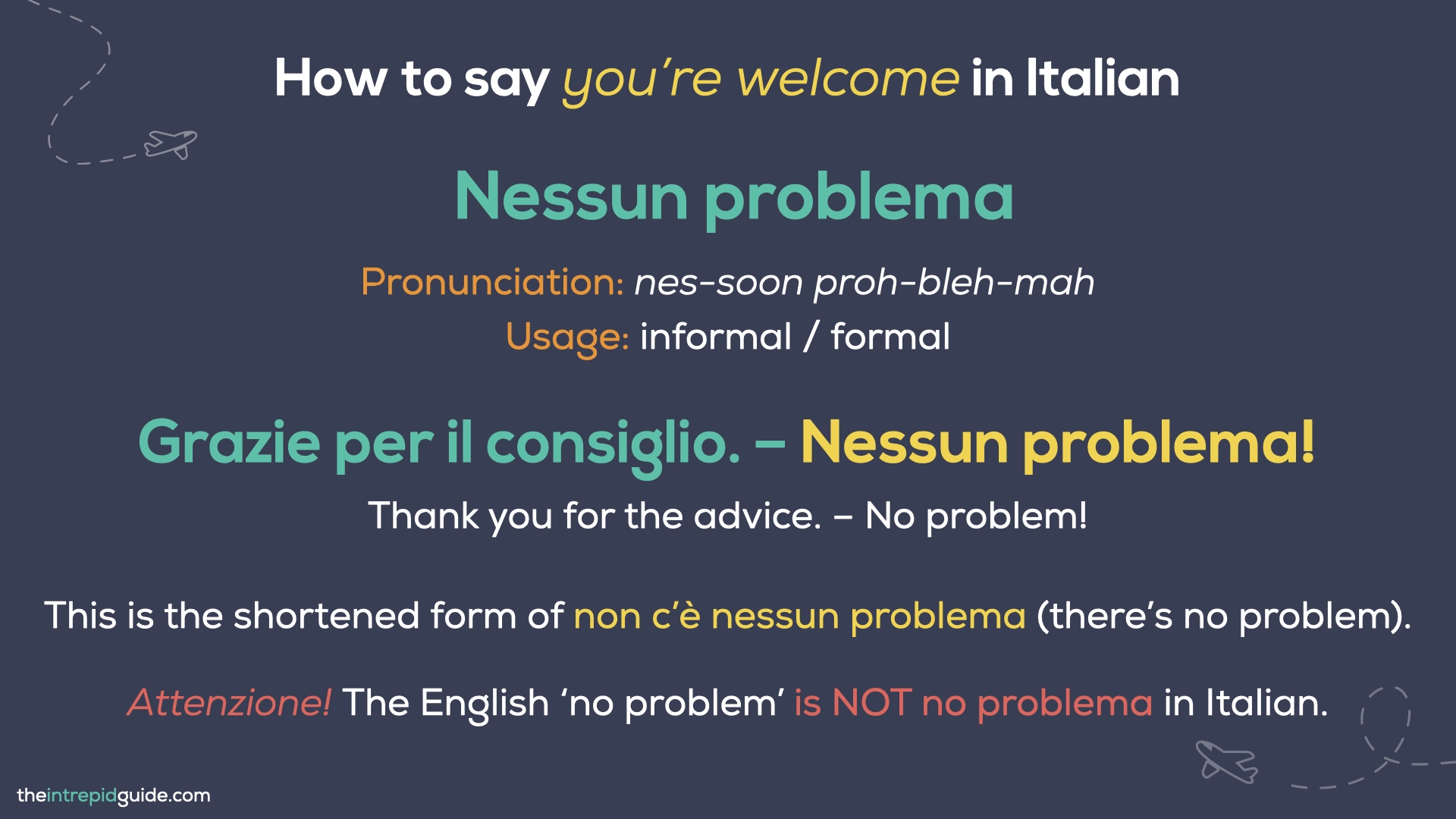 The next one is another common phrase Italians use to say “you’re welcome”. Unlike some of the previous expressions we’ve seen so far, the meaning of “nessun problema” can be literally translated to “no problem”. It conveys the idea that giving help or assistance to someone didn’t cause you any inconvenience. This phrase is actually the shortened form of “non c’è nessun problema”, meaning “there’s no problem”.
The next one is another common phrase Italians use to say “you’re welcome”. Unlike some of the previous expressions we’ve seen so far, the meaning of “nessun problema” can be literally translated to “no problem”. It conveys the idea that giving help or assistance to someone didn’t cause you any inconvenience. This phrase is actually the shortened form of “non c’è nessun problema”, meaning “there’s no problem”.
Attenzione! (Careful!) If you’re a beginner in Italian you would probably translate the English “no problem” with “no problema” in Italian, which is a very common mistake. However, the word “no” in Italian is not used in these kinds of expressions, but only as a reply to a question. Check my guide to see the most deadly mistakes Italian beginners make!
8. Piacere mio / È stato un piacere
Pronunciation: pee-ah-cheh-reh mee-oh / eh stah-toh oon pee-ah-cheh-reh
Usage: formal
Example: Grazie per essere venuti. – È stato un piacere (Thank you all for coming. – It was a pleasure.)
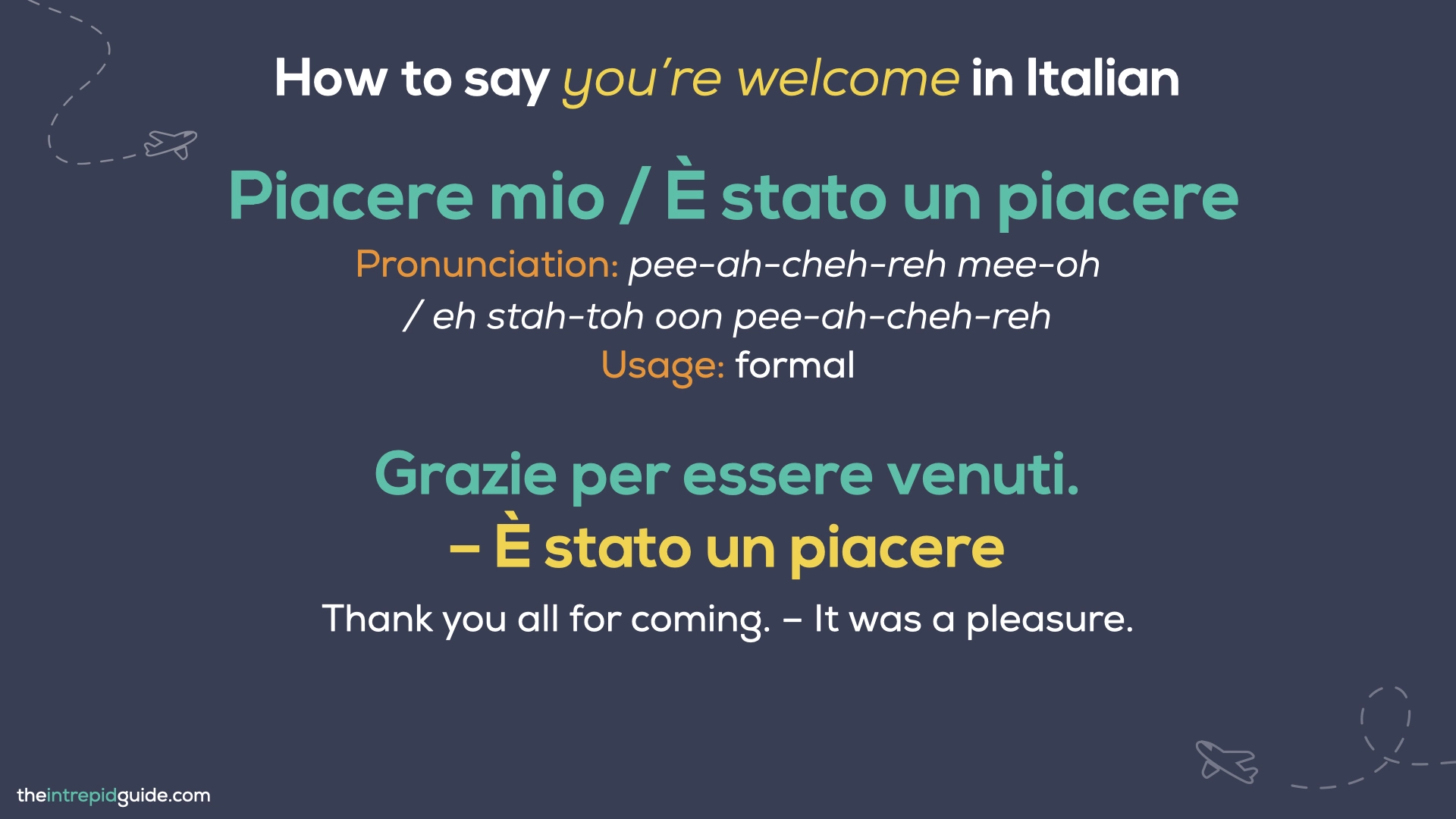 Another way to say “you’re welcome” in Italian is with “piacere mio” (my pleasure) or its variation “è stato un piacere” (it was a pleasure), which conveys the idea of you enjoying assisting or doing something for someone, as in “I don’t/ didn’t mind helping, in fact, I am/ was happy to!”.
Another way to say “you’re welcome” in Italian is with “piacere mio” (my pleasure) or its variation “è stato un piacere” (it was a pleasure), which conveys the idea of you enjoying assisting or doing something for someone, as in “I don’t/ didn’t mind helping, in fact, I am/ was happy to!”.
Remember that “è stato un piacere” refers to the past, so it’s only really appropriate to use it when the act of helping has already taken place. These expressions are both quite formal, so you won’t hear them very often in informal contexts, such as among friends.
9. Assolutamente
Pronunciation: ah-ssoh-loo-tah-mehn-teh
Usage: informal
Example: Grazie per avermi invitato. – Assolutamente. (Thanks for inviting me. – Absolutely)
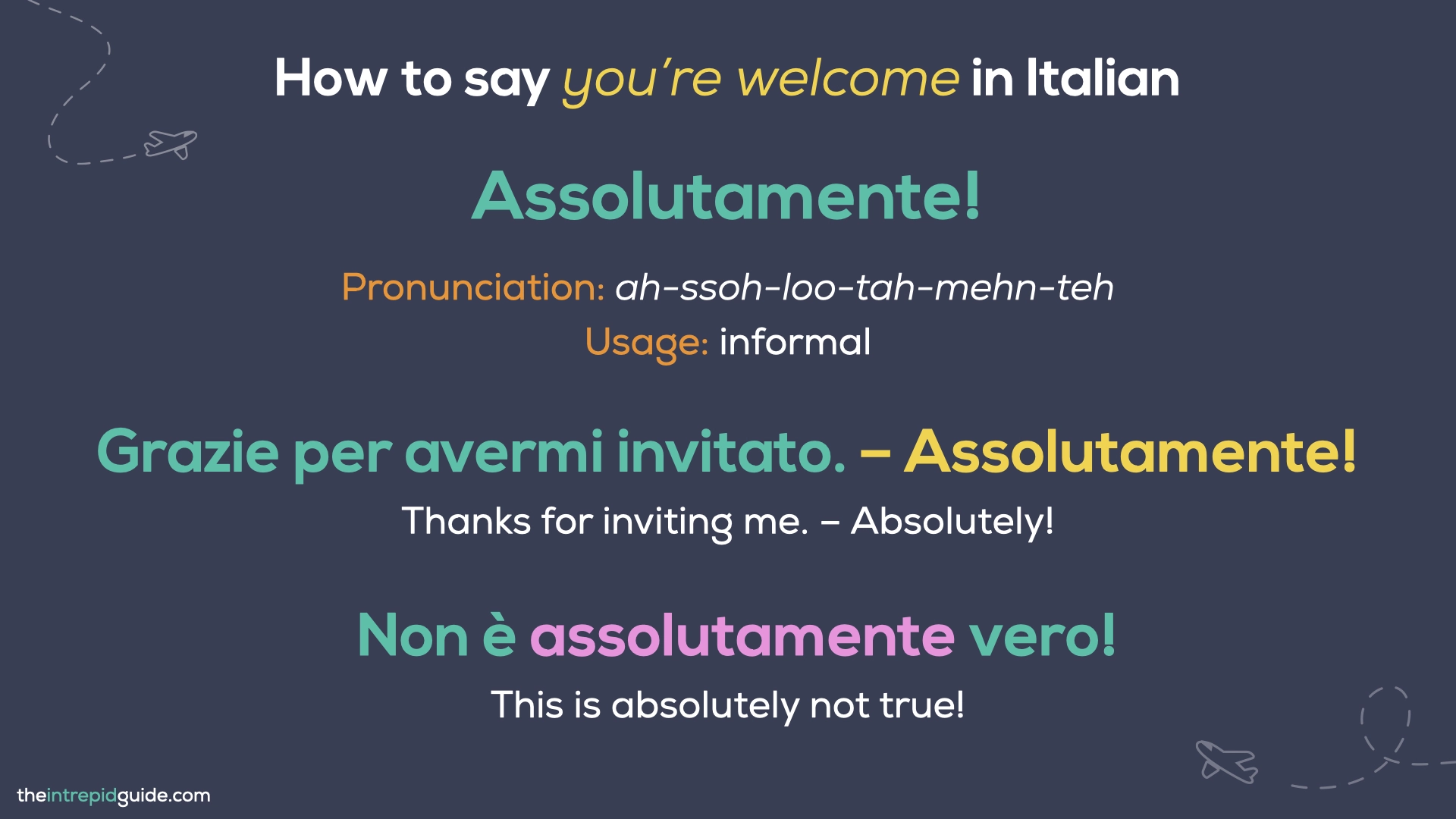 This word is used to say “you’re welcome” in Italian. It is quite informal and translates to the English word “absolutely”, which can be used as an adverb in other kinds of sentences too. For example: Non è assolutamente vero! (This is absolutely not true!)
This word is used to say “you’re welcome” in Italian. It is quite informal and translates to the English word “absolutely”, which can be used as an adverb in other kinds of sentences too. For example: Non è assolutamente vero! (This is absolutely not true!)
10. Non c’è di che
Pronunciation: nohn cheh dee keh
Usage: formal
Example: Grazie per l’informazione. – Non c’è di che (Thank you for the information. – Anytime/ Don’t mention it.)
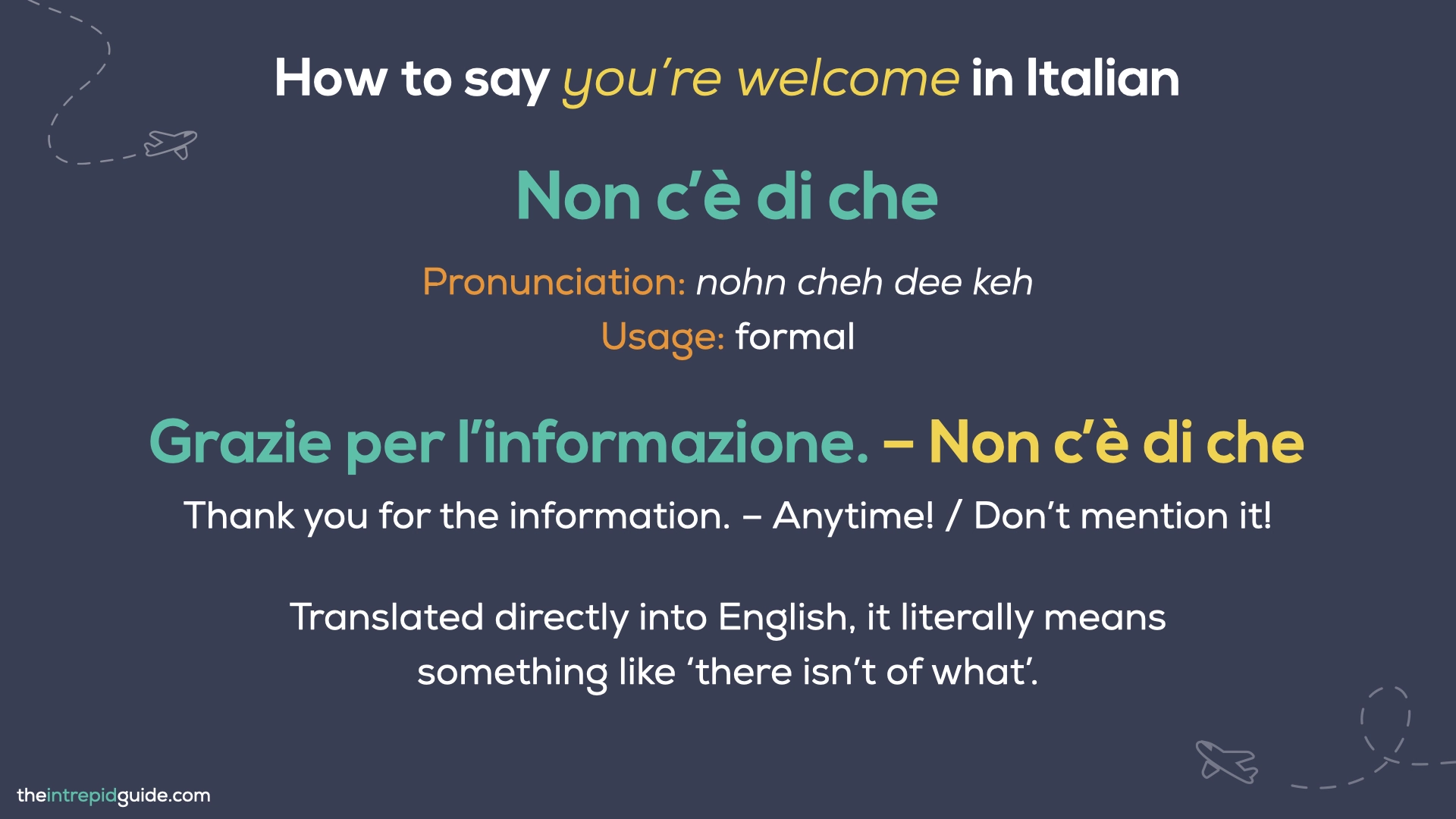 Last but not least is “Non c’è di che”, a more colourful way to say “you’re welcome” in Italian. “Non c’è di che” is very idiomatic and therefore impossible to translate directly into English (literally, it means something like “there isn’t of what”). It is quite formal and very polite.
Last but not least is “Non c’è di che”, a more colourful way to say “you’re welcome” in Italian. “Non c’è di che” is very idiomatic and therefore impossible to translate directly into English (literally, it means something like “there isn’t of what”). It is quite formal and very polite.
Conclusion
Now that you’ve learned all the common ways Italians say “you’re welcome”, go, and be creative! Next time your Italian friends express their gratitude, practice these alternative expressions to add variety to your speech (and remember, try not to use “prego” all the time!).
Notice how many of the phrases above are used figuratively and not literally. It might be hard at first to know when to use these idiomatic expressions but the more you practice and immerse yourself in the language, the sooner you’ll master them and you’ll sound like a real native speaker!
P.S. Here are the answers from the exercises in the first section where you learned about “Prego”.
Here is the meaning of “prego” alongside each sentence:
- Prego Signori, da questa parte. (Meaning: Please)
- Grazie, sei davvero gentile. – Prego! (Meaning: You’re welcome)
- Buongiorno, prego! – Salve, vorrei un cappuccino e un cornetto, per favore. (Meaning: What can I get you? / Ready to order?)
- Sono una persona molto religiosa, prego tutti i giorni. (Meaning: I pray)
- Ieri ho cucinato i paccheri al salmone. – Prego? (Meaning: What was that? / Sorry?)
- Posso usare il telefono? – Prego! (Meaning: Go ahead)
Now you know all the ways to “you’re welcome”, watch these videos to learn how to say “thank you” and “please” in Italian like a native!
 Are you a beginner or an intermediate Italian learner? Got a trip coming up or want to communicate with your Italian partner or relatives in Italian? Learn Italian with my unique 80/20 method
Are you a beginner or an intermediate Italian learner? Got a trip coming up or want to communicate with your Italian partner or relatives in Italian? Learn Italian with my unique 80/20 method
Registrations are now open to join Intrepid Italian, my new series of online video courses that use my unique 80/20 method. You’ll go from a shy, confused beginner to a proficient and confident intermediate speaker, with me as your trusty guide.
You’ll finally be able to connect with your Italian partner, speak to your relatives and enjoy authentic travel experiences in Italy that you’ve always dreamed of, and so much more.
As a native English speaker who learned Italian as an adult, I know what it’s like to feel hopeless and lack the confidence to speak. I know what it’s like to start from scratch and to even go back to absolute basics and learn what a verb is!
Intrepid Italian was created with YOU in mind. I use my working knowledge of the English language to help you get into the ‘Italian mindset’ so you can avoid the common pitfalls and errors English speakers make – because I made them once too! I break everything down in such a way that it ‘clicks’ and just makes sense.
No matter what your level is, there is an Intrepid Italian course for you, including:
- 🇮🇹 Intrepid Italian for Beginners (A1)
- 🇮🇹 Intrepid Italian for Advanced Beginners (A2)
- 🇮🇹 Intrepid Italian for Intermediates (B1)
You can join 1, 2, or all 3 courses, it’s entirely up to you. The best part is that you have lifetime access so you learn anytime, anywhere and on any device.
As your guide, I walk you through each lesson, step-by-step, using my unique 80/20 method. My approach is different from traditional methods because I teach you the most important 20% of the language right from the beginning so you can start to speak straight away.
Each course includes video lessons, audio exercises, downloadable worksheets, bonus guides, a private support community, and lifetime access all designed to streamline your learning while having fun.
It even comes with my famous “Celebrate with a Spritz Guarantee”. After 30 days of using Intrepid Italian, if you don’t want to celebrate your new-found Italian skills with an Aperol Spritz, you don’t have to pay a penny! Cheers! 🥂
Join Intrepid Italian here and start learning today!
Ci vediamo lì! (See you there!)
Learning Italian? Check out these Italian language guides
- Italian for Beginners | How to Learn Italian in 3 Simple Steps
- TOP 100 Most Common Italian Words (Plus PDF Cheat-Sheet & Quiz)
- I’m Sorry in Italian | Different Ways to Say Sorry, Excuse me, and Forgive me
- How to say ‘Please’ in Italian in 9 Ways Like a Native
- 41 Italian Greetings: How to Say ‘Hello’ in Italian Like a Local
- 125 Most Common Italian Phrases for Travel You’ll Ever Need [PLUS Printable]
- 8 DEADLY mistakes in Italian (& How to Avoid Them)
- How to Conjugate Italian Verbs in 3 Simple Steps [Italian for Beginners]
- Is Italian Hard to Learn? 7 Common Mistakes & How to Avoid Them
- Master Days of the Week in Italian (7 Simple Memory Hacks)
- Italian Numbers: How to Count in Italian From 0 to 1 Billion (Plus PDF Download)
- How to Order Food & Drinks in Italian [Italian for Beginners]
- 15 Italian Words You Should NEVER Mispronounce [& How Not To]
- 11 Effective Hacks That’ll Help You Learn Italian So Much Faster
- Top 14 Italian Words You Should NEVER Say [& What to Use Instead]
- 20 Hilarious Everyday Italian Expressions You Should Use
- Romanesco: 25 Cool Roman Dialect Words You Should Use in Rome
- 10 Reasons Why Learning Italian Will Change Your Life
- 10 Italian Expressions Italians Love Saying
- 10 Italian Phrases That Will Instantly Make You Sound more Italian
- Funny Italian Sayings: 26 Food-Related Insults You Won’t Forget
- 15 Romantic Italian Films That’ll Make You Love Italy Even More
- How to Master Common Italian Phrases for Travel (Like a Local!)
Like it? Pin it for later!

Over to you!
Which of these phrases do you use the most to say “you’re welcome”? Which one is your favourite? Let me know using the comments section below or join me on social media to start a conversation.
Thanks for reading and I hope you enjoyed this post.
Like what you see? Subscribe using the form below to have all of my posts delivered directly to your email.

